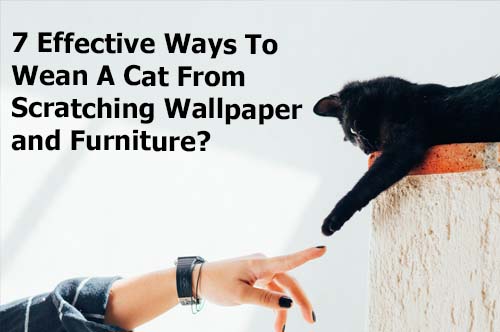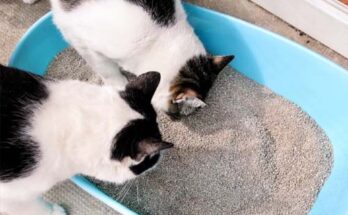How To Wean A Cat From Scratching Wallpaper and Furniture? This is one of the most common problem of almost every pet owner. A cat in the house is interesting and pleasant, but sometimes a pet behaves badly and even spoils the property. A common problem is scratching wallpaper and furniture. But you can wean a pet from such habits! Today, we come with most effective and useful ways to wean a cat from scratching and biting.

Why Do Cats Fight Furniture and Wallpapers?
Many members of the feline family living in houses and apartments tear wallpaper and home decoration. This is due to their physiology and the characteristics of instincts and behavior. Here on SensePot, we have the solution from our experts.
There Are Several Reasons:
- Inadequate, absent or untimely upbringing. Cats are smart, and the owner has the power to instill in the pet rules of behavior, but not everyone brings up the pets correctly and on time.
- Highly rooted habit. If you took an adult cat from the street or from other owners, and she scratched the wallpaper before meeting you, then she will continue in the same way in new housing.
- Claw update. Friction on any objects during scratching allows you to remove dead particles of the claw plates.
- Designation of the territory. On the tips of the paws between the fingers are special glands that secrete a secret. And with this substance, cats mark their possessions during scratching (they also do this with urine and glands located in other places – in the cheeks and under the tail).
- Boredom. If a pet does not have toys and a place for games, he will splash out energy with scratching and damage to property.
- Jealousy. A cat can be jealous of its owners for other pets or children. Scratching is a way to attract attention and mark territory.
- Competition with other animals. If there are several pets in the house, then everyone will protect the property and seek to conquer the territory.
Organization of personal territory and places for scratching
How can wean a cat to scratch wallpaper and furniture? When getting a pet, you should understand that he will need a personal space in which there will be everything necessary for a comfortable and active life. Be sure to provide a play area by placing a scratching point or multi-level stand with rough and soft areas for scratching.
Show the cat her corner, demonstrate what you can do with certain objects. If you manage to attract the pet’s attention and he appreciates the idea, then he’ll most likely use the scratching post for its intended purpose, and forget about furniture and walls.
The claw tip should be comfortable. There are different types: racks, planks, rugs, deck chairs, posts and entire complexes. The device should appeal to the pet, so you probably have to try out a few options. In addition, the accessory must be safe and securely fixed, because if it falls on the cat, it will be scared and will no longer come to the scratching post.
Important! Be sure to provide the cat with toys for an active and enjoyable pastime. It gives a great help to wean a cat.
Special tools
There are many specialized tools for correcting the behavior of pets. The first category is sprays for weaning from scratching. They have sharp unpleasant odors and are sprayed into the pet’s favorite areas. But some cats adapt to aromas or do not notice them.
The second category of funds – sprays for accustoming to the scratching post. On the contrary, they attract the attention of an animal and have pleasant smells. First, the cat draws attention to the site, her mood improves and becomes playful, she begins to release her claws and have fun, and the fragrance reinforces positive emotions. So, they will be able to wean a cat.
Correction of behavior, education and care
In principle, to wean a cat from bad habits is realistic at any age, but the sooner you start to do this, the higher the chances of correcting the animal and making it educated. Tips will help:
- Spray bottle with water. As soon as the cat starts to tear up the sofa or comes up to it, spray it into the face with water. You need to do this often or constantly, so that the pet understands the relationship of its actions and discomfort. The method will take time and patience, but in many cases it works.
- Noise. Noticing the pet’s intentions to sharpen its claws or an already begun action, make a loud sound, for example, shake a rattle or rustle with a plastic bag. Representatives of the cat family do not like sharp noises and are scared of them, so if you carry out manipulations every time you try to scratch the wallpaper, the animal will soon realize that this is not worth it.
- Vote. When a pet starts to tear up wallpaper or comes to a favorite place, shout it loudly, pronounce a nickname roughly and clearly or say words like “You can’t”, “Spray”, “Kysh”, “Stop”. Intonation must be strict.
- Be gentle and attentive to the cat. Perhaps her bad behavior is an attempt to attract the attention of the owners, to throw out energy. Communicate with your pet, talk, play, praise it, spend more time together, do not let us get bored. Then the desire to scratch the furniture and wallpaper does not arise, and there will be no time and effort left.
Folk methods & Try folk remedies:
- Liqueur Valerian grease her claw.
- Catnip will also draw the cat’s attention to the place reserved for grinding claws.
- In places where you want to “drive off” your pet, spray citrus fruit juice, vinegar .
- Hang a cotton pad on the furniture or wall with a sharp-smelling essential oil or a cloth bag with aromatic spices.
If weaning fails
What if the cat, after all your attempts at weaning, still continues to tear everything that falls under its paws? There are several ways to minimize property damage:
- Anti-scratch . These are silicone pads, fixed on the claws of a cat and making them absolutely not sharp. But the pet should be accustomed to such accessories from an early age, as in a later animal the animal will experience discomfort. In addition, anti-scratches change the position of the claws (they cannot be removed in a calm state) and often cause allergic reactions.
- Cover your cat’s places with protective pads, for example, with planks of chipboard or fiberboard. And so that such panels are used for their intended purpose, it is better to supplement them with familiar materials, about which the pet usually sharpens its claws: wallpaper, paper or fabric.
- Regular clipping of claws . Get a special nail clipper and, as it grows, carefully cut the claws. Of course, the cat will continue to use the claws anyway, but they will be less sharp and will not harm objects much.
Important! Claw removal is a radical and inhumane measure that should not be taken.
Patience of the owner and his correct behavior will help to wean a cat from scratching furniture and wallpaper!


